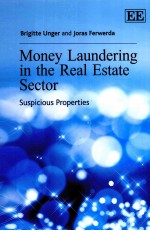图书介绍
MONEY LAUNDERING IN THE REAL ESTATE SECTORpdf电子书版本下载

- BRIGITTE UNGER 著
- 出版社: EDWARD ELGAR
- ISBN:1849801266
- 出版时间:2011
- 标注页数:175页
- 文件大小:11MB
- 文件页数:184页
- 主题词:
PDF下载
下载说明
MONEY LAUNDERING IN THE REAL ESTATE SECTORPDF格式电子书版下载
下载的文件为RAR压缩包。需要使用解压软件进行解压得到PDF格式图书。建议使用BT下载工具Free Download Manager进行下载,简称FDM(免费,没有广告,支持多平台)。本站资源全部打包为BT种子。所以需要使用专业的BT下载软件进行下载。如 BitComet qBittorrent uTorrent等BT下载工具。迅雷目前由于本站不是热门资源。不推荐使用!后期资源热门了。安装了迅雷也可以迅雷进行下载!
(文件页数 要大于 标注页数,上中下等多册电子书除外)
注意:本站所有压缩包均有解压码: 点击下载压缩包解压工具
图书目录
1. Introduction 1
Part One: Economic Approach 5
2. The Real Estate Sector 7
2.1. Size and volume of the real estate sector 8
2.2. The Dutch real estate market 11
2.3. The actors in the real estate market 14
2.4. Some very specific characteristics of the Dutch real estate market: mortgages and taxes 17
2.5. Speculation is an inherent characteristic of the real estate market 17
2.6. The attractiveness of real estate for money laundering 19
3. Forms of Criminal Real Estate Abuse 21
4. Research Method and Indicators 29
4.1. Research method 29
4.2. Indicators 32
5. Operationalizing the Indicators and Data Collection 47
5.1. Data sources 47
5.2. Merging the datasets 50
5.3. Indicators 51
6. Descriptive Data Analysis 63
6.1. The indicators 63
6.2. Comparison of total number of red flags 80
6.3. Comparison between houses and industry 80
7. Evaluation of the Research Method 83
7.1. Correlations 83
7.2. Distribution of red flags per object 85
Part Two: Criminological Analysis&by Luuk Ritzen and Hans Nelen 89
8. Concepts, Methods and Analysis 91
8.1. The concept of conspicuousness and the use of narrative theory 91
8.2. Top-down analysis 92
8.2.1. Top-down phase la: creating case descriptions 92
8.2.2. Top-down phase lb: preparing a data matrix 95
8.2.3. Top-down phase lc: final considerations 101
8.3. Top-down phase 2a: adding 'intelligence' 102
8.3.1. Acquiring fiscal closed source information 102
8.3.2. Acquiring judicial closed source information 102
8.3.3. Top-down phase 2b: finalizing the data matrix 103
8.4. Top-down phase 3: applying the conspicuous label 105
8.5. Bottom-up analysis: gathering 'field intelligence' 107
8.5.1. Sources 107
8.5.2. Comparing the data 109
9. Results of the Criminological Analysis 111
9.1. The selected objects 111
9.2. Results top-down phase 1 112
9.3. Results top-down phase 2 112
9.4. The conspicuous cases 114
9.4.1. Fraud cases 116
9.4.2. Drug cases 118
9.4.3. Irregularities in rent cases 122
9.4.4. Final remarks 124
9.5. Results bottom-up 125
10. Major Findings of the Criminological Analysis 127
10.1. Verifying or falsifying the stated hypotheses 127
10.2. Remarkable findings in the data 128
10.3. Remarkable findings in the top-down analysis 128
10.4. Elaborating on the conspicuous cases 129
Part Three: Statistical and Econometric Analysis 133
11. Linking the Economic and Criminological Parts 135
12. Descriptive Statistics of the Dataset 137
12.1. Frequency analysis 138
12.2. Do more red flags indicate conspicuous cases? 141
12.3. Correlation analysis 141
13. Econometric Analysis 145
13.1. Missing values 145
13.2. Limited dependent variable 146
13.3. Results 146
14. Major Findings 151
15. Suggestions for Further Research 155
16. Summary 159
References 163
Index 171